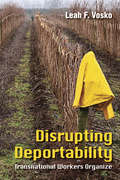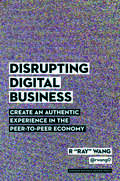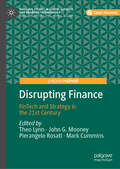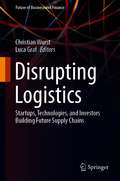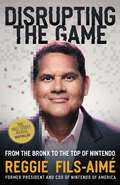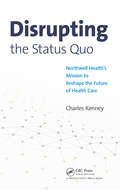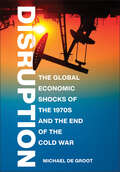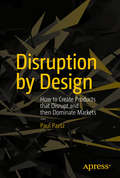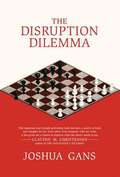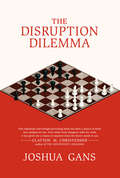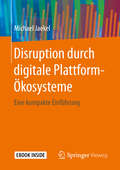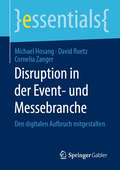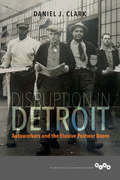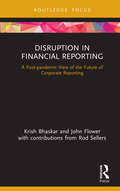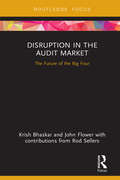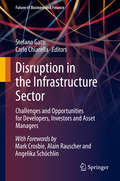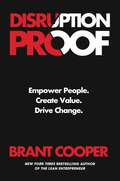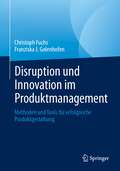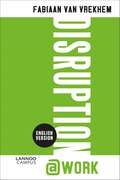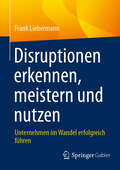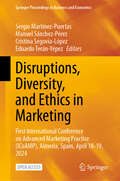- Table View
- List View
Disrupting Deportability: Transnational Workers Organize
by Leah F. VoskoIn an original and striking study of migration management in operation, Disrupting Deportability highlights obstacles confronting temporary migrant workers in Canada seeking to exercise their labor rights. Leah F. Vosko explores the effects of deportability on Mexican nationals participating in Canada's Seasonal Agricultural Worker Program (SAWP).Vosko follows the decade-long legal and political struggle of a group of Mexican SAWP migrants in British Columbia to establish and maintain meaningful collective representation. Her case study reveals how modalities of deportability—such as termination without cause, blacklisting, and attrition—destabilize legally authorized temporary migrant agricultural workers. Through this detailed exposé, Disrupting Deportability concludes that despite the formal commitments to human, social, and civil rights to which migration management ostensibly aspires, the design and administration of this "model" temporary migrant work program produces conditions of deportability, making the threat possibility of removal ever-present.
Disrupting Digital Business
by R Ray" WangWe are no longer an economy of products and services. The digital transformation demands that we focus our attention on experiences and outcomes. Business leaders and their organizations must shift to keeping promises-no matter how their customers interact with them.But organizations no longer control the conversation. In this era of social and mobile technology, customers, employees, suppliers, and partners are in direct communication with one another. Those personal networks and the brands they're passionate about influence their decision making and their spending.The workforce has changed too. Employees expect to be able to determine when and how they will work, the technology they'll use, and the values their company will espouse.Organizations can take part in this conversation only if they recognize how and where it's happening. Resisting these changes will leave executives, managers, and their companies powerless. Organizations must pivot with and ahead of these social, organizational, and technological shifts or risk being left behind.Technology guru Ray Wang shows how organizations can surf the waves of change-how they can keep their promises. Current trends, when taken seriously, require a new way of thinking about business that includes five key areas:1. Consumerization of technology and the new C-suite2. Data's influence in driving decisions3. Digital marketing transformation4. The future of work5. Matrix commerceDigital disruption has changed how we do our work. But by mastering these trends you'll delight your customers with every interaction.
Disrupting Finance: FinTech and Strategy in the 21st Century (Palgrave Studies in Digital Business & Enabling Technologies)
by Theo Lynn John G. Mooney Pierangelo Rosati Mark CumminsThis open access Pivot demonstrates how a variety of technologies act as innovation catalysts within the banking and financial services sector. Traditional banks and financial services are under increasing competition from global IT companies such as Google, Apple, Amazon and PayPal whilst facing pressure from investors to reduce costs, increase agility and improve customer retention. Technologies such as blockchain, cloud computing, mobile technologies, big data analytics and social media therefore have perhaps more potential in this industry and area of business than any other. This book defines a fintech ecosystem for the 21st century, providing a state-of-the art review of current literature, suggesting avenues for new research and offering perspectives from business, technology and industry.
Disrupting Justice at RightNow: Persevere, Pivot or Perish
by Amir Reza Rezvani Shikhar GhoshThe case examines the focus of an early stage company, and how an unexpected external incidence can threaten or void the business model. It encompasses issues such as defining and pivoting a business model, organizational requirements for a pivot, investor relations, disruptive business models, as well as business conduct in continental Europe. In 2017, Dr. Torben Antretter, a former competitive tennis player and academic researcher, founded RightNow with his two co-founders. RightNow was set out to provide consumers with "Justice-as-a-Service" by purchasing their legal claims that they would not pursue otherwise. Just one year after its inception, the company had closed a 25 million financing to increase its market share and leverage further growth opportunities. Upon closing of this financing round, matters took a sudden and unexpected turn when the National Supreme Court announced a ruling that airlines were no longer required to refund flight tickets. This decision wiped out RightNow's profit margins. Antretter and his co-founders had to decide what they should do with the business. How should the founders approach investors? Should they quit and walk away from their entrepreneurial dream or try to reinvent the business with a different focus? What would be the strategy going forward?
Disrupting Justice at RightNow: Rich or King
by Amir Reza Rezvani Shikhar GhoshThe case examines issues such as cascading problems within the organization, changing founder roles, founder success criteria, as well as company exit consideration. In 2017, Dr. Torben Antretter, a former competitive tennis player and academic researcher, founded RightNow with his two co-founders. RightNow was set out to provide consumers with "Justice-as-a-Service" by purchasing their legal claims that they would not pursue otherwise. Three years after inception and after overcoming numerous consecutive hurdles, the company was entering its next stage of its lifecycle. The selection of an investor type would be instrumental to the next few years of the company and the lives of the founders. With success, considerations around company exit and defining success criteria became inevitable. Different investors types had different investment criteria with regards to target returns, growth ambitions, decision rights, and ownership stakes. Antretter and his co-founders had to decide, jointly as well as individually, what they want to do. Discussions among the founding team showed that they needed to develop an 'exit strategy' in the same way that they had developed a growth strategy. When should they consider an exit and take some chips off the table? Was it more important to become rich or to remain kings of their kingdom?
Disrupting Logistics: Startups, Technologies, and Investors Building Future Supply Chains (Future of Business and Finance)
by Christian Wurst Luca GrafThis book presents trends, developments, and examples of how digital disruption is currently reshaping the logistics industry. Logistics is the invisible force behind the global economy, influencing and providing a lens into all economic activities. Chapters written by respected experts in the field describe how new technologies such as autonomous vehicles, blockchain, Internet of things (IoT), and state-of-the-art freight management solutions are fundamentally changing supply chain solutions. Special emphasis is placed on promising start-ups and venture capital firms around the world that are now investing in the future of logistics."Supply chains hold significant room for optimization to the benefit of customers, industry participants, authorities and the environment. This book provides a unique set of perspectives from industry leaders covering a wide range of topics. It is a ‘must read’ for anyone seeking to understand and contribute to a better tomorrow in supply chains logistics." — Thomas Bagge, Chief Executive Officer and Statutory Director DCSA“The need for standardisation and digitalisation in logistics is no longer an option. This book gives insights from industry experts, shows trends and innovations in platforms, underlines the need for transparency and how big data and analytics can make a world of difference. It’s an incredible resource if you wish to better understand the new normal of logistics.” — Global Chief Digital & Information Officer, MSC Mediterranean Shipping Company"This book presents readers with a straightforward and comprehensive assessment of supply chain innovation and trends and their impact on the industry. With contributions from several industry leaders, it provides critical knowledge and insight that supply chain and logistics managers need to implement disruptive technologies strategically.” — Rene Jacquat, Founder / Advisor, LogiChain Solutions
Disrupting the Game: From the Bronx to the Top of Nintendo
by Reggie Fils-AiméReggie Fils-Aimé, retired President and Chief Operating Officer of Nintendo of America Inc., shares leadership lessons and inspiring stories from his unlikely rise to the top. Although he&’s best known as Nintendo's iconic President of the Americas-immortalized for opening Nintendo&’s 2004 E3 presentation with, &“My name is Reggie, I'm about kicking ass, I'm about taking names, and we're about making games&”-Reggie Fils-Aimé&’s story is the ultimate gameplan for anyone looking to beat the odds and achieve success.Learn from Reggie how to leverage disruptive thinking to pinpoint the life choices that will make you truly happy, conquer negative perceptions from those who underestimate or outright dismiss you, and master the grit, perseverance, and resilience it takes to dominate in the business world and to reach your professional dreams.As close to sitting one-on-one with the gaming legend as it gets, you will learn:About the challenges Reggie faced throughout his life and career-from his humble childhood as the son of Haitian immigrants, to becoming one of the most powerful names in the history of the gaming industry.What it takes to reach the top of your own industry, including being brave enough to stand up for your ideas, while also being open to alternative paths to success.How to create vibrant and believable visions for your team and company.How to maintain relentless curiosity and know when to ask questions to shatter the status quo.
Disrupting the Meat Industry: Tissue Culture Beef
by Jose B. Alvarez Matthew PrebleDr. Mark Post and his team at Maastricht University were perfecting their tissue culture beef product-made entirely from muscle grown in his lab-to give it the same taste, texture and appearance of a traditional beef hamburger. A previous iteration of this product had been taste tested live, with good results, and Sergey Brin, a co-founder of Google, had provided Post with much of the funding to make the burgers. The next step was to form an independent company around this technology and take it to market. This innovative product could both radically disrupt the existing beef production and supply chain, and provide an animal welfare and environmentally-friendly food that had far less of an environmental impact than traditional beef products. Post faced several challenges in making this a commercially viable product though. He had to get price down, as it currently cost roughly $330,000 to make a single burger. He also had to find the right partner(s) to help him bring the product to market, but who should he work with: someone from the established beef production and supply system, a retailer, or someone entirely outside the traditional beef system? How could he expect established companies to react to this disruption of the status quo? Messaging around this product was critical: How should Post communicate with the public to convey that this was a natural product-the way muscle tissue grew in his lab was the same way it developed in cattle-and overcome public skepticism of overt scientific involvement in their food?
Disrupting the Status Quo: Northwell Health's Mission to Reshape the Future of Health Care
by Charles KenneyWe are in the midst of what may well be the most confusing, turbulent period in the history of modern medicine. This book seeks to cut through the fog and confusion that enshrouds the health care industry to provide clarity on where the industry stands today and where it is headed. The book defines the major challenges in health care through the journey of Northwell Health, one of the largest provider organizations in the country. The central issues in what is nearly one-fifth of the United States economy are played out daily within this not-for-profit organization. Northwell is New York state’s largest workers, and $11 billion in annual revenue. The book candidly portrays key leaders within Northwell on the most vexing challenges in health care: How to provide primary and specialty care spending; how to create and sustain an internal system of continuous learning to enable employees at all levels to stay current in an industry that is changing at warp speed; how to provide emergency services in a world where natural disasters and acts of terrorism are inevitable; how to identify new revenue streams to offset reductions from Medicare and Medicaid; and how to push outside the walls of hospitals and clinics to improve the overall health of individuals and communities by working on determinants of health beyond the typical medical practice. The book exists at the intersection of medicine, business, social and public policy. Harvard’s Michael Porter has written widely on health care arguing that it is time "for a fundamentally new strategy," but what, exactly? Where is the industry headed? What do the changes and the turbulence mean for patients, doctors, nurses? This book is the product of a learning journey both humbling and rewarding. Over time, lessons learned, improvements made, innovations conceived, have advanced Northwell Health in ways that, some years ago, might not have seemed possible. Northwell has become a national leader not because it is perfect, but because it remains steadfast in its journey to remain humble enough to know that whatever success may be achieved, the journey is about continuous learning and improvement. The goal of the book is to provide a deeper, clearer understanding of what is happening in health care and why; to help illuminate a pathway forward for patients and caregivers most of all, but also for policy-makers and the employers and others who pay for care.
Disruption: The Global Economic Shocks of the 1970s and the End of the Cold War
by Michael De GrootIn Disruption, Michael De Groot argues that the global economic upheaval of the 1970s was decisive in ending the Cold War. Both the West and the Soviet bloc struggled with the slowdown of economic growth; chaos in the international monetary system; inflation; shocks in the commodities markets; and the emergence of offshore financial markets. The superpowers had previously disseminated resources to their allies to enhance their own national security, but the disappearance of postwar conditions during the 1970s forced Washington and Moscow to choose between promoting their own economic interests and supporting their partners in Europe and Asia. De Groot shows that new unexpected macroeconomic imbalances in global capitalism sustained the West during the following decade. Rather than a creditor nation and net exporter, as it had been during the postwar period, the United States became a net importer of capital and goods during the 1980s that helped fund public spending, stimulated economic activity, and lubricated the private sector. The United States could now live beyond its means and continue waging the Cold War, and its allies benefited from access to the booming US market and the strengthened US military umbrella. As Disruption demonstrates, a new symbiotic economic architecture powered the West, but the Eastern European regimes increasingly became a burden to the Soviet Union. They were drowning in debt, and the Kremlin no longer had the resources to rescue them.
Disruption by Design
by Paul PaetzFrom Eli Whitney to Henry Ford to Ray Kroc to Steve Jobs, market disruptors have reaped the benefits, including fame and fortune. But do you have to be that rare genius whose unique skills can literally change the world? No. Disrupting a market is a discipline that can be learned. Disruption by Design--a handbook for entrepreneurs, CEOs, product developers, innovators, and others who want to build products or create services that systematically disrupt markets--is the first book that shows you how. There is a huge difference between being an 'innovator' and being a 'disruptive innovator. ' Disruptors change the basis for competition in markets, and they end up controlling market share--typically 40 to 80% of the total revenue and half or more of the total profits in the categories they create. But while many market opportunities have disruptive potential, only a small fraction of those ever succeed in disrupting markets. And, too often, those that do disrupt do so by accident. It doesn't have to be that way. Disruption by Design conveys lessons learned from successful disruptors, and from the many companies that should have disrupted but failed. Beginning with a quick review of the theory and key elements of the patterns of disruptive innovations and how to identify ideas with disruptive potential, Disruption by Design guides you through the design, build, and go-to-market phases that successful disruptors follow. Using many examples of disruptive companies and products, this book takes the popular theory of disruptive innovation and drives it down to the level of practical application. It answers the question, 'How do I create a disruptive company, product, and culture?' Disruption by Design:
The Disruption Dilemma
by Joshua Gans"Disruption" is a business buzzword that has gotten out of control. Today everything and everyone seem to be charaterized as disruptive -- or, if they aren't disruptive yet, it's only a matter of time before they become so. In this book, Joshua Gans cuts through the chatter to focus on disruption in its initial use as a business term, identifying new ways to understand it and suggesting new tools to manage it. Almost twenty years ago Clayton Christensen popularized the term in his book The Innovator's Dilemma, writing of disruption as a set of risks that established firms face. Since then, few have closely examined his account. Gans does so in this book. He looks at companies that have proven resilient and those that have fallen, and explains why some companies have successfully managed disruption -- Fujifilm and Canon, for example -- and why some like Blockbuster and Encyclopedia Britannica have not. Departing from the conventional wisdom, Gans identifies two kinds of disruption: demand-side, when successful firms focus on their main customers and underestimate market entrants with innovations that target niche demands; and supply-side, when firms focused on developing existing competencies become incapable of developing new ones. Gans describes the full range of actions business leaders can take to deal with each type of disruption, from "self-disrupting" independent internal units to tightly integrated product development. But therein lies the disruption dilemma: A firm cannot practice both independence and integration at once. Gans shows business leaders how to choose their strategy so their firms can deal with disruption while continuing to innovate.
The Disruption Dilemma
by Joshua GansAn expert in management takes on the conventional wisdom about disruption, looking at companies that proved resilient and offering managers tools for survival. “Disruption” is a business buzzword that has gotten out of control. Today everything and everyone seem to be characterized as disruptive—or, if they aren't disruptive yet, it's only a matter of time before they become so. In this book, Joshua Gans cuts through the chatter to focus on disruption in its initial use as a business term, identifying new ways to understand it and suggesting new tools to manage it. Almost twenty years ago Clayton Christensen popularized the term in his book The Innovator's Dilemma, writing of disruption as a set of risks that established firms face. Since then, few have closely examined his account. Gans does so in this book. He looks at companies that have proven resilient and those that have fallen, and explains why some companies have successfully managed disruption—Fujifilm and Canon, for example—and why some like Blockbuster and Encyclopedia Britannica have not. Departing from the conventional wisdom, Gans identifies two kinds of disruption: demand-side, when successful firms focus on their main customers and underestimate market entrants with innovations that target niche demands; and supply-side, when firms focused on developing existing competencies become incapable of developing new ones. Gans describes the full range of actions business leaders can take to deal with each type of disruption, from “self-disrupting” independent internal units to tightly integrated product development. But therein lies the disruption dilemma: A firm cannot practice both independence and integration at once. Gans shows business leaders how to choose their strategy so their firms can deal with disruption while continuing to innovate.
Disruption durch digitale Plattform-Ökosysteme: Eine kompakte Einführung
by Michael JaekelDisruption ist das Schlagwort einer Digitalmoderne, in der digitale Plattform-Ökosysteme eine neue Ökonomie erzeugen. Es expandiert eine Plattform-Ökonomie, die etablierte Unternehmen und Industrien in ihren Grundfesten erschüttert. Die Erschütterungen werden von dem Phänomen der Disruption ausgelöst. In Literatur und Praxis wird der Begriff der Disruption aber inflationär für nahezu alles herangezogen. Daher zielt das vorliegende kompakte Buch auf die kohärente Klärung des Begriffs der Disruption als ein Axiom der Digitalmoderne ab. Zudem erläutert der Autor die Expansionsdynamiken digitaler Plattform-Öko-Systeme durch Big Data-Management und Anwendungen der schwachen Künstlichen Intelligenz. Die Ausführungen zeigen die Relevanz der Disruptionstheorie praxisorientiert am Beispiel der digitalen Transformation eines großen Verlagshauses. Der Autor bietet mit seinem Werk Denkwerkzeuge und -anregungen, jedoch keinen schablonenhaften Ratgeber. Damit richtet sich das Buch an alle, die sich mit disruptiven Dynamiken der Digitalisierung kritisch auseinandersetzen und eigene Gedanken weiterentwickeln möchten.
Disruption in der Event- und Messebranche: Den digitalen Aufbruch mitgestalten (essentials)
by Cornelia Zanger David Ruetz Michael HosangDieses essential beschreibt, inwieweit Digitalisierungsprozesse sowie disruptive Technologien in der Event- und Messebranche bereits angestoßen und umgesetzt werden und beantwortet die folgenden Fragen: Wie reagieren Event- und Messeteilnehmer und teilnehmerinnen auf den Einsatz der neuen Technologien? Welche Rolle spielen digitale Tools im Hinblick auf Kaufentscheidungen und mit welchen neuen Anforderungen müssen sich Mitarbeiter und Mitarbeiterinnen aufgrund stetiger Anpassungen an veränderte Arbeitsweisen auseinandersetzen?
Disruption in Detroit: Autoworkers and the Elusive Postwar Boom (Working Class in American History #288)
by Daniel J. ClarkIt is a bedrock American belief: the 1950s were a golden age of prosperity for autoworkers. Flush with high wages and enjoying the benefits of generous union contracts, these workers became the backbone of a thriving blue-collar middle class. It is also a myth. Daniel J. Clark began by interviewing dozens of former autoworkers in the Detroit area and found a different story--one of economic insecurity caused by frequent layoffs, unrealized contract provisions, and indispensable second jobs. Disruption in Detroit is a vivid portrait of workers and an industry that experienced anything but stable prosperity. As Clark reveals, the myths--whether of rising incomes or hard-nosed union bargaining success--came later. In the 1950s, ordinary autoworkers, union leaders, and auto company executives recognized that although jobs in their industry paid high wages, they were far from steady and often impossible to find.
Disruption in Financial Reporting: A Post-pandemic View of the Future of Corporate Reporting (Disruptions in Financial Reporting and Auditing #3)
by Krish Bhaskar John FlowerSince the global financial crisis of 2007–8, new laws and regulations have been introduced with the aim of improving the transparency in financial reporting. Despite the dramatically increased flow of information to shareholders and the public, this information flow has not always been meaningful or useful. Often it seems that it is not possible to see the wood for the trees. Financial scalds continue, as Wirecard, NMC Health, Patisserie Valerie, going back to Carillion (and many more) demonstrate. Financial and corporate reporting have never been so fraught with difficulties as companies fail to give guidance about the future in an increasingly uncertain world aided and abetted by the COVID-19 pandemic. This concise book argues that the changes have simply masked an increase in the use of corporate PR, impression management, bullet points, glossy images, and other simulacra which allow poor performance to be masked by misleading information presented in glib boilerplate texts, images, and tables. The tone of the narrative sections in annual reports is often misleading. Drawing on extensive research and interviews with insiders and experts, this book charts what has gone wrong with financial reporting and offers a range of solutions to improve information to both investors and the public. This provides a framework for a new era of forward-looking corporate reporting and guidance based on often conflicting multiple corporate goals. The book also examines and contrasts the latest thinking by the regularity authorities. Providing a compelling exploration of the industry’s failings and present difficulties, and the impact of future disruption, this timely, thought-provoking book will be of great interest to students, researchers, and professionals as well as policy makers in accounting, financial reporting, corporate reporting, financial statement analysis, and governance.
Disruption in the Audit Market: The Future of the Big Four (Disruptions in Financial Reporting and Auditing)
by Krish Bhaskar John FlowerFocussing on the dominance of the Big Four auditing firms – PwC, EY, Deloitte and KPMG – this concise volume provides an authoritative critical assessment of the state and future of the audit market, currently the subject of much debate and the focus of significant government enquiries. Drawing on extensive research and a vast collection of evidence from interviews with insiders, experts and users, it explores the key issues of audit quality, independence, choice and the growing expectation gap. Just as disruptive technologies are overturning other established sectors, this book explores their impact on accounting, financial reporting and auditing. It questions whether the Big Four-dominated audit market is prepared not only for the inevitable disruption of new technologies, but also the challenges of negative public perceptions, cynicism about regulation and demands for greater transparency. In the context of increasing high-profile corporate failures, this book provides a compelling scrutiny of the industry’s failings and present difficulties, and the impact of future disruption. At this crucial time, it will be of great interest to students, researchers and professionals in accounting and auditing, as well as policy makers and regulators.
Disruption in the Infrastructure Sector: Challenges and Opportunities for Developers, Investors and Asset Managers (Future of Business and Finance)
by Stefano Gatti Carlo ChiarellaA number of dramatic changes are currently reshaping infrastructure, a sector that investors and asset managers have traditionally considered to be a safe harbor in the field of alternative investments. Understanding the future of infrastructure is indispensable to guaranteeing a sustainable future for our planet and the welfare of the world’s population, and enhancing our knowledge of this asset class is one important step we can take toward reaching this crucial goal. This book collects a series of contributions by a group of Bocconi University researchers under the Antin IP Associate Professorship in Infrastructure Finance, which cover the key megatrends that are expected to reshape the way we think about infrastructure, and the implications for infrastructure investors and asset managers. Its goal is to improve and disseminate the culture of infrastructure among academics, professionals and policymakers. The main focus is on Europe and the European Union, and specifically on three key sectors: power and energy, transportation infrastructure, and telecoms / ICT.
Disruption Proof: Empower People, Create Value, Drive Change
by Brant CooperCEO and founder of Moves the Needle and New York Times bestselling author of The Lean Entrepreneur Brant Cooper teaches leaders how to ensure their organizations are resilient, agile, and dynamic enough to endure long-term, weathering the storms of disruption and uncertainty. One thing in life is certain: change is constant. Thanks to the rapid pace of technological innovation in the digital age—and further accelerated by the global COVID-19 pandemic—massive structural change is happening on a greater scale than ever before. Faced with unprecedented complexity and uncertainty, most business leaders struggle to see the way forward. Company organization, systems, and management are still largely based on what was most effective in the Industrial Age. Disruption Proof offers a new approach that addresses our current reality. Through powerful case studies of notable corporations like Intuit, 3M, Cargill, and more, Cooper demonstrates how, with the right mindset and practical strategies, companies that focus on creating value for customers can thrive in the 21st century. Disruption Proof provides readers with detailed methods for progressing through four stages of implementation to embrace a new way of working company-wide, including how to: develop an understanding of customers and colleagues that lead to insights (empathy)run tests to challenge assumptions (exploration)leverage data and insights to breakthrough biases (evidence)balance operational execution with learning (equilibrium)manage behavior to match corporate values (ethics) By adopting these 5Es, company leaders can empower employees to become creative problem solvers, ensuring their company&’s ability to navigate moments of crisis and find transformative opportunities. Cooper explains how reimagining work at every level is the key to organic and sustainable growth, and guides leaders to create lasting value in the world. With Cooper's action-oriented advice and tools, anyone can help steer their company towards durable success.
Disruption Spreads Its Wings: The Future of Aviation
by Scott D. Anthony Erik A. Roth Clayton M. ChristensenThe dynamics of disruption have been playing out dramatically in the aviation industry. This chapter describes how regional jet manufacturers have encroached on the established market, how incumbents are hindered by their processes and structures, and how incumbents are responding to the disruption.
Disruption und Innovation im Produktmanagement: Methoden und Tools für erfolgreiche Produktgestaltung
by Christoph Fuchs Franziska J. GolenhofenDieses Buch ist ein unverzichtbarer Leitfaden für jeden, der an der Konzeption und Entwicklung von Produkten beteiligt ist. Es beantwortet zwei grundlegende Fragen: Wie können Unternehmen einen Innovationsprozess und ein Umfeld gestalten, das für ein erfolgreiches Produktdesign förderlich ist? Und: Wie kann man ein Produkt retten, wenn das ursprüngliche Konzept die Markterwartung der Kunden nicht erfüllt?Die Autor*innen erläutern, wie Unternehmen Innovationsansätze und den Grundsatz „Form follows Function" in der Systemarchitektur vereinen. Sie zeigen Methoden wie Market Understanding, Design Thinking, Design to Value, Modularisierung und Agility auf, die in Zeiten von Disruption, Unsicherheit und Komplexität unentbehrlich geworden sind und in zahlreichen Branchen erprobt wurden. Mit vielen Erfahrungsberichten, Beispielen und Fallstudien sowie hilfreichen Tools zur praktischen Anwendung. "Auf der grundlegendsten Ebene bringt dieses Buch Ordnung ins Chaos. Es setzt unterschiedliche und hochrelevante Designansätze zu komplementären Lösungsansätzen für das Problem zusammen. Produktdesigner, Manager, Berater, Wissenschaftler und Studierende werden dieses wertvolle Buch sicher täglich zur Hand haben." Olivier L. de Weck, Ph.D. – MIT Professor für Luft- und Raumfahrttechnik und Engineering Systems, Chefredakteur Systems EngineeringDieses Buch stellt die Übersetzung einer englischsprachigen Originalausgabe dar. Die Übersetzung wurde mit Hilfe von künstlicher Intelligenz erstellt (maschinelle Übersetzung mit DeepL.com). Eine anschließende manuelle Überarbeitung erfolgte vor allem nach inhaltlichen Gesichtspunkten, so dass das Buch stilistisch von einer herkömmlichen Übersetzung abweicht.
Disruption@WORK
by Fabiaan Van VrekhemWe are living in an age of accelerated change. The internet has washed away all limitations on time and space. Entrepreneurship has been democratized, and economies have globalized. Innovation has rendered entire sectors irrelevant in the blink of an eye. This is the reality any manager has to take into account in order to keep his company viable. Disruption@WORK taps into the roots of disruptive change, and offers a guide in recognising disruption, defining the ways in which it has already had an effect, and what awaits us in tomorrow's board rooms. In doing this, Disruption@WORK provides a view on the factors we have to deal with in bridging the gap between the individual, his work and corporate strategy, in order to face the future of our companies.
Disruptionen erkennen, meistern und nutzen: Unternehmen im Wandel erfolgreich führen
by Frank LiebermannDas Buch geht den Fragen nach, was Disruption ist, wie sie abläuft und welche technologischen und wirtschaftlichen Faktoren sie auslösen. Es untersucht, wie Unternehmen Disruptionen frühzeitig erkennen und bewältigen können. Dabei zeigt es die Phasen von den ersten Anzeichen bis zur Marktdominanz der Disruptoren auf. Besonderes Augenmerk wird auf die technologischen und wirtschaftlichen Treiber sowie auf die Strukturen gelegt, die dazu führen, dass Unternehmen zu langsam reagieren. Der fundierte Praxisteil beschreibt ein Framework, das anhand von Analysetools und Checklisten darlegt, wie sich Unternehmen auf Disruptionen vorbereiten können.
Disruptions, Diversity, and Ethics in Marketing: First International Conference on Advanced Marketing Practice (ICoAMP), Almeria, Spain, April 18-19, 2024 (Springer Proceedings in Business and Economics)
by Sergio Martínez-Puertas Manuel Sánchez-Pérez Cristina Segovia-López Eduardo Terán-YépezAs the marketing landscape continues to evolve, posing fresh challenges for both academics and practitioners, this book explores contemporary marketing issues, trends, challenges, and opportunities. Featuring papers presented at the first annual International Conference on Advanced Marketing Practice (ICOAMP) held in Almería, Spain in 2024, this open access book covers a broad range of topics focused analytics, measurements, and methodologies in marketing, health, medical and beauty decision-making; the impact of digital technologies on marketing management; marketing education; marketing oriented to operational data stores (ODS); non-profit marketing; marketing ethics (CSR) and social media, and digital marketing practices, among others. These topics are centered around three pivotal and interrelated themes: disruptions, diversity, and ethics, which are the cornerstones that drive our collective pursuit of understanding their impact on the world of marketing. It is imperative for modern businesses and marketers alike to grasp the intricacies of these factors and their implications. This book provides valuable contributions for marketing researchers and practitioners as well as managers of businesses in a wide range of industries
